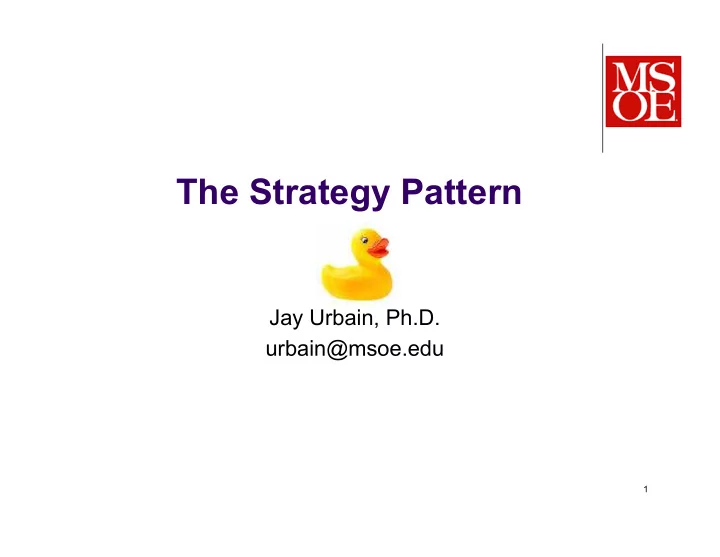

The Strategy Pattern Jay Urbain, Ph.D. urbain@msoe.edu 1
Review What problems are we trying to avoid? 2
Review What problems are we trying to avoid? l Class explosions l Code duplication l Tight Coupling l Poor Cohesion What do we want to achieve? 3
Review What problems are we trying to avoid? l Class explosions l Code duplication l Tight Coupling l Poor Cohesion What do we want to achieve? l Modifiable behaviors l Ease of maintenance l High cohesion 4 l Loose coupling
Applying the Strategy Pattern Leave behavior that is truly <<abstract>> Duck shared in abstract classes. Duck Isolate behavior(s) that vary and declare interfaces that define those behaviors. Mallard Implement the behaviors in Mallard(name: String) : void separate concrete classes whose references can be passed to a Duck constructor. 5 SimUDuck v5 + urbain version
Consider Collections.sort() Collections.sort() uses a reference to a concrete class that implements the Comparable interface, and thus the behavior of the compare() method. Depending on the strategy of the compareTo() method in the concrete class, different sorting will be used by Collections.sort(). The comparison strategy is decoupled from the Collections.sort() method itself. 6
Consider Collections.sort() // method prototype void Collections.sort(List<T> list) // usage: get highest priority type for domain Collections. sort( freebaseMqlEntityList ); Implementation: public class FreebaseMqlEntity implements Comparable<FreebaseMqlEntity> { @Override public int compareTo(FreebaseMqlEntity arg0) { if( this.getPriority() < arg0.getPriority() ) { return -1; } else if( this.getPriority() > arg0.getPriority() ) { return 1; } else { return 0; } 7 }
The Strategy Design Pattern in its general form: The Context is the class that encapsulates and uses a specific behavior, or Strategy. A Strategy is an interface that defines a behavior ConcreteStrategy classes implement specific behaviors
Applying the Strategy Pattern: step 1 The Strategy Pattern is a behavioral pattern usually considered and applied at design-time. Premise: Your application requires similar objects whose behavior varies. 9
Applying the Strategy Pattern: step 2 As a designer, you watch for inheritance patterns that result in excessive behavior overrides and/or code duplication among classes. 10
Applying the Strategy Pattern: step 3 Leave behavior that is truly <<abstract>> Duck shared in abstract classes. Duck Isolate behavior(s) that vary and declare interfaces that define those behaviors. Mallard Implement the behaviors in Mallard(name: String) : void separate concrete classes whose references can be passed to a Duck constructor. 11 SimUDuck v5 + urbain version
Inside a concrete Duck class public class Mallard extends Duck { // constructor public void Mallard(String name) { // create some (concrete) behaviors super(name, new CircularSwimming(), new StandardQuacking()); … 12
Inside a an abstract Duck class public abstract class Duck{ SwimBehavior sb; QuackBehavior qb; String name; // constructor public void Duck(String name, SwimBehavior sb, QuackBehavior qb) { this.name = name; swimBehavior = sb; quackBehavior = qb; } // centralize implementation of behaviors in top-level classes // avoid duplication of behavior in subclasses. public void swim() { swimBehavior.swim(); // invoke the specific behavior } 13 ...
Other good design principles we visited Code to the highest level of abstraction possible: ArrayList<Thing> = new ArrayList<Thing> // bad i. List<Thing> = new ArrayList<Thing> // good ii. Collection<Thing> = new ArrayList<Thing> // better iii. Example: List<Duck> duckList = new ArrayList<Duck>(); Duck d1 = new Mallard(“daffy”): duckList.add( d1 ); Duck d2 = new RubberDuck(“donald”): duckList.add( d2 ); for(Duck duck : duckList) { System.out.println( d.getName() ); d.quack(); d.swim(); }
Strategy is a Behavioral Design Pattern The Strategy pattern allows for selection of specific behavioral algorithms at runtime , since the selected strategy is just an attribute of the class using the Strategy. l We can select particular behavioral strategies when we construct the Ducks! l And since the swim () or quack () behaviors of Duck are just attributes (references) to concrete Strategy classes, we could easily change the behaviors at any time with a simple setSwimBehavior() mutator method! – Rubber duck behaves like Mallard!
The Strategy pattern favors Encapsulation over Extension l Instead of changing the behavior implemented within a derived class by extending from a parent class, we encapsulate behaviors into a class as instance attributes, which can be varied. l The Strategy pattern lets us vary and change behavioral algorithms independently of the clients that use the behaviors.
A good Design Pattern has also solved a larger conceptual issue: To make a program easy to maintain, we always want to strive for High cohesion 1. Low coupling 2. 17
Coupling: How closely two or more classes are related Does changing code in one class require changes in another class?? l If “yes”, then it has high coupling (bad) l Changing swim or quack behaviors does not require changes to the Duck class (low coupling) 18
Other design principles benefitting from the Strategy Pattern l Decreases coupling, increases cohesion l The behavior of the Duck is not coupled to the Duck – behaviors are implemented separately. l Like all Design Patterns, the Strategy pattern allows us to vary a part of the system (swim and quack behavior) independently of other parts
Are there disadvantages? l Yes: the implementation of the Strategy Pattern is somewhat more sophisticated than using simple inheritance l All design patterns usually exhibit this type of tradeoff. 20
Other good design principles we visited l Code to the most restrictive level of access modification that is possible in a given context: Use public for constants and methods; never for i. attributes. On methods: only on those you want to support for public consumption Use /*package*/ if cooperating classes in the same ii. package need access to attributes or special methods Use protected to allow derived classes in any package iii. access to members Use private to completely guard members from view iv. outside the defining class
Recommend
More recommend